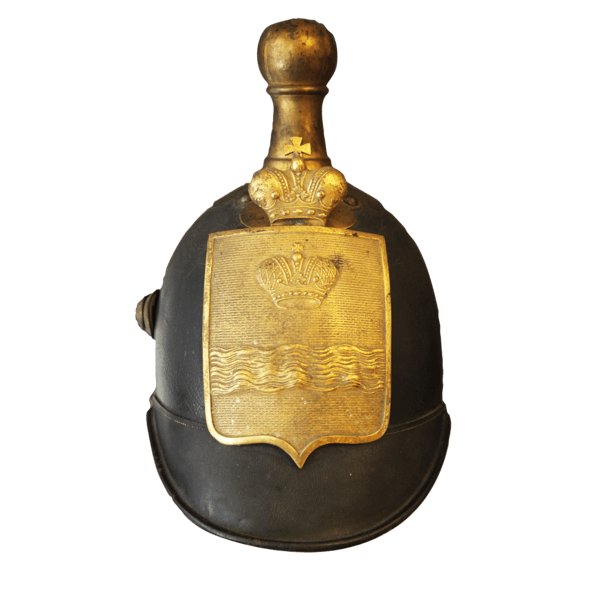In 1855, black helmets with the governorate’s emblem of yellow metal became an indispensable element of the Russian policeman’s outfit. The copper plate on the helmet shows the coat of arms of the Kaluga Governorate, which was established on March 10, 1777.
The shape of this helmet is called zishagge. A dome-shaped helmet ends in an elevation with a knob - a pommel. This hollow tube had two ventilation holes, and during hot weather, policemen could open and close them by turning the tube.
This type of helmets was developed personally by Nicholas I of Russia at the turn of the 1830-1840s with the help of Lev Kiel, a painter and officer who created a series of etchings themed Russian Military Uniforms. The new headgear was designed based on the combination of cuirassier and Old Russian helmets.
Spiked helmets were made of leather and varnished. They were very impractical: contemporaries claimed that when the helmet got wet in the rain and then dried up in the sun, it dwindled, shrank and scorched. However, the project was eventually deemed successful, and in 1844 such helmets replaced usual caps. The reform dragged on for three years: the cost of the new outfit for sizable military staff was enormous.
The helmet proved completely useless in battles. A leather helmet did not protect the head from shell and shrapnel, and, what is more, it stuck out above the trench making the soldier an easy target. In 1856, helmets were abolished in infantry units, then the police, and later removed from the formal military dress of the guard.
However, spiked helmets were put into use in another country. In 1837, Prince Charles of Prussia brought an engineering prototype home from Russia presented to him by Nicholas I of Russia. Charles dreamed of making impressive helmets a must-have item for the military, but his father, King Frederick William III of Prussia, adamantly opposed the idea. The prince was able to put the idea into life only five years later, after his elder brother Frederick William IV took the throne.
Spiked helmets remained a recognizable element of the German military uniform until the collapse of the German Empire in 1918. Perhaps this was the reason for the misconception that such helmets first appeared in the German army.
The shape of this helmet is called zishagge. A dome-shaped helmet ends in an elevation with a knob - a pommel. This hollow tube had two ventilation holes, and during hot weather, policemen could open and close them by turning the tube.
This type of helmets was developed personally by Nicholas I of Russia at the turn of the 1830-1840s with the help of Lev Kiel, a painter and officer who created a series of etchings themed Russian Military Uniforms. The new headgear was designed based on the combination of cuirassier and Old Russian helmets.
Spiked helmets were made of leather and varnished. They were very impractical: contemporaries claimed that when the helmet got wet in the rain and then dried up in the sun, it dwindled, shrank and scorched. However, the project was eventually deemed successful, and in 1844 such helmets replaced usual caps. The reform dragged on for three years: the cost of the new outfit for sizable military staff was enormous.
The helmet proved completely useless in battles. A leather helmet did not protect the head from shell and shrapnel, and, what is more, it stuck out above the trench making the soldier an easy target. In 1856, helmets were abolished in infantry units, then the police, and later removed from the formal military dress of the guard.
However, spiked helmets were put into use in another country. In 1837, Prince Charles of Prussia brought an engineering prototype home from Russia presented to him by Nicholas I of Russia. Charles dreamed of making impressive helmets a must-have item for the military, but his father, King Frederick William III of Prussia, adamantly opposed the idea. The prince was able to put the idea into life only five years later, after his elder brother Frederick William IV took the throne.
Spiked helmets remained a recognizable element of the German military uniform until the collapse of the German Empire in 1918. Perhaps this was the reason for the misconception that such helmets first appeared in the German army.



